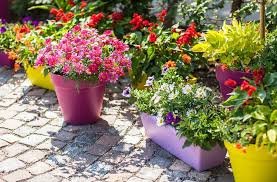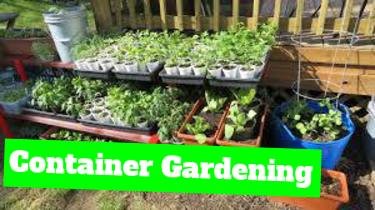What Is Container Gardening?
Container gardening also known as pot gardening is the practice of growing plants in containers instead of planting them on the ground.
This practice has been for existence for many years and many gardeners are still using it to grow vegetables, flowers and other non-edible plants in their homestead.
Containers such as portable box, basket, tin, raised bed, hanging basket or pots are filled with good quality soil.
Watering is done and plants are planted on the containers.
It’s advisable to use containers that have good drainage and aeration mechanisms so as to prevent root rot.

This gardening method is popular in areas with little gardening space such as urban zones or in areas where the available soil type is not ideal for specific plants.
Container gardening methods use less water, reduces spread of pest and diseases and gardeners are able to closely monitor their plants due to their frequent interactions.
On the other hand, there are a few downsides of this gardening method. Let’s look at some of the pros and cons of container gardening in details.
Advantages of Container Gardening
It requires less space
Container gardening requires a very little space to supply you with fresh plants compared to the traditional open-field gardening.
Therefore, people living in urban areas where space is limited are able to benefit from growing plants in their apartments and backyards thanks to container gardening.
Containers are portable
If you are moving, you can easily take the container garden with you to your new home. In addition, containers can be moved in areas that are favorable for optimal growth.
For, instance, you can move your container in an area with adequate sunlight or even indoors during unfavorable weather conditions.
Less labor requirements
Unlike other gardening methods where the gardener is required to regularly weed, container gardens have limited weeds and gardeners are saved hours of weeding which leads to time consumption and sometimes back pain.
Customization
There are many varieties of containers that one can choose. Gardeners can become creativity and come up with unique designs that will make their living areas more attractive.
Indoor container gardens also helps in transforming interior house designs.
One can even play around with a mixture of unique container arrangement, mixed plants and container shapes and sizes.
Easy to control pest & diseases
If one plant in a container is affected by pest or a disease, it becomes easier to treat the plant. There is also, low risk of the pest and diseases to spread to other plants compared to an open-field gardening.
Plants are closely monitored at regular intervals and the gardener is able to identify any affected plants in good time.
Container gardens are ideal for starters
For beginners in urban gardening, use of containers can help them practice agriculture with little investment and inputs.
In situations where losses are incurred, gardeners only loose the plants which dry up as compared to other gardening methods where high inputs and labour are required.
Container gardens are easy to secure
Due to their close proximity to our living spaces, container gardens are easy to monitor. Therefore, they are protected from theft, animals and pest infestation. That is not the case with other gardening methods since security cannot be guaranteed.
Disadvantages of Container Gardening
They require regular watering
Because container plants can’t access ground water, they require constant watering. In addition, the amount of water that they can retain is also dependent on the container size. Therefore, the plants requires to be watered more frequently to prevent them from drying up.
It can only accommodate few plants
The number of plants that one can grow in a container garden is limited compared to open-field gardening.
The size of container dictates the number of plants that can be accommodated at a given time.
Read Also; Hydroponic fodder Disadvantages
Soil requires regular replacement
Due to the limited capacity, the soil nutrients gets depleted after growing a number of plants thus, demanding replenishment.
This requires regular soil replacement or use of fertilizer which might increase the operating cost.
Containers pricing
There are different varieties of container gardens on the market today.
If you are looking for a unique containers that will give your home or backyard an aesthetic feature, be ready to spend more money.
The pricing of the containers is also dependent on the materials used plus the artistic work done on them to make them look astounding.
Plants That Can Be Grown In Containers
Not all plants that can be grown in containers. Vegetables, flowers and herbs are the best plants that can do well in container gardening.
If you are just starting up container gardening or you are aspiring to do so, I would recommend that you start with the following plants;
- Lettuce and related vegetables
- Herbs
- Tomatoes
- Onions
- Radishes
- Peppers
Types of Containers Used In Container Gardening
Container gardens vary in terms of size, materials, design, color and themes. As a gardener, you should go for a container that complements your home decor and the one that matches well with the plants and flowers that you intend to grow.
Containers varieties include;
- Clay pots
- Windowsill holders/wall pots
- Hanging baskets
- Wooden boxes
- Stone containers

